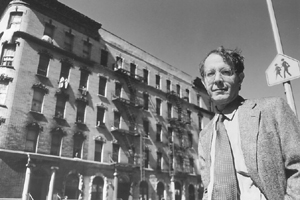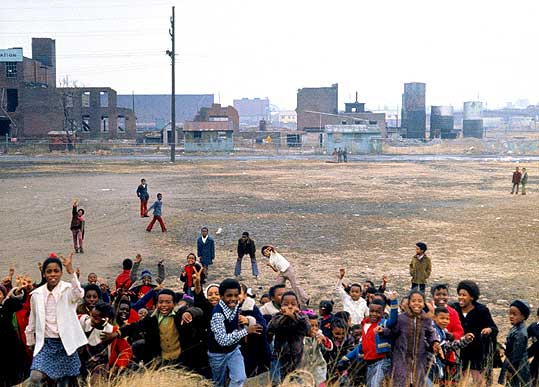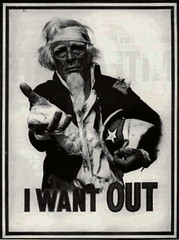
Who goes to war? Who gets sent to fight bullshit battles in bullshit places by the lies of cowardly blowhards and braggarts who loll in the seats of power given to them by accidents of birth? Who gets carried into the field hospitals, appendages dangling by threads of skin, brains scrambled by blast-induced concussions, and who gets forgotten and left to fend for themselves the moment they make it home, turned out of the military that betrayed them as useless for further cannon-fodder?
The children of the poor, that's who. Children of the poor and ghettoized, forgotten, thrown away, then suddenly remembered when the recruiters need warm bodies. Children who grow up in a nation that has abdicated its responsibility to educate and integrate its people, that has used every downturn in the economy as an excuse to fracture the public school system, and failed to restore funding cuts when times got good again. Children in a country that increasingly sees them, if it sees them at all, as widgets to plug into the cheap labor market, or in the case of the military, the cheap life department, and whose schooling options seldom include paths to creative, well-paying opportunities, but more likely offer "sewing", or "hairdressing".
In the most recent edition of Harper's, Jonathan Kozol, a former teacher and ongoing observer of the nation's schools, writes the cover story, "Still Separate, Still Unequal". Kozol is the author of two of the most powerful books ever written on the American education system: Savage Inequalities, and Amazing Grace: Lives of Children and the Conscience of a Nation. And his latest foray shows that not only has nothing changed, but despite Bush's much ballyhooed "Texas miracle", the situation seems to have been exacerbated by the kind of apartheid not seen in this country since 1965.
Anyone who lives or works in a big city made up of a diverse racial population can see it. The city schools have become darker and darker, while the suburbs and private schools fill up with white children. I live next door to Chestnut Hill, the richest neighborhood in Philadelphia, and I would defy anyone to find me a single family there who sends its kids to the only available public high school: hulking, deteriorated Germantown High, with its overflow of students, its dark, smelly hallways, and its regular flareups of violence. You won't even find it listed under Ch. Hill's website's list of schools, because it's a forgone conclusion that those who can afford to live there wouldn't think of sending their kids to GHS.
And while Bush's experiments in education as governor of Texas were part of his "Education President" election platform that gave rise to the current testing craze fueling his NCLB program, it's worth recalling that the result of the Texas experiment was a tapestry of lies and hokum that relied on cooked data whose underlying fabrications were all too readily overlooked by an administration eager to crow about its success. And it's also worth recalling that the majority of these wasted efforts were aimed at poor and minority schools, whose students remain about as badly off as they were when compassionate George stalked the Austin mansion.

Kozol begins by laying out the numbers: big city public schools range anywhere from 75% to more than 97% non-white (my example above, GHS, currently shows 98.1% black and .8% white). In spite of the lip service given to the advance of civil rights issues over the last decades, the demographics of our schools give the lie to our insistence that equal opportunity is a done deal. As a nation we have ignored how schools and neighborhoods have slipped back into the Jim Crow look of the early 20th century, and we pretend that the inequalities between them have no basis in race. As Kozol notes, the word “diversity” becomes a euphemism for the absence of whites, and thus the vocabulary of civil rights is turned against itself in the service of guilt-free segregation.
In what are the most heart-rending passages of the article, Kozol relates the conversations of the kids sentenced to do time in these literal hellholes. Think of your own school memories. Do you recall being squeezed, 5 classes of different grades, into a single windowless room? Watching rainwater flowing down the stairwells when it rained? Barrels collecting water as it came through the ceiling? Collapsing ceilings, rats in the classrooms and eating the food off the shelves before the kids could get to it, nowhere to play or exercise, no toilet paper in the restrooms, no restrooms at all? These kids want to know why they have to try to learn under these conditions, and why they can’t have a little of what other children and their parents not only get, but fully expect as their rightful due:
“Dear Mr. Kozol,” wrote the eight-year old,”we do not have the things you have. You have Clean things. We do not have. You have Parks and we do not have Parks. You have all the thing and we do not have all the thing. Can you help us?”Libraries. Art. Music. School doctors. All gone with the wind at the first sign of budget crunches, and never to be seen again when the economy got better. Kozol relays the current per-pupil spending rate in New York City--$11,700—which may sound like a princely sum until you read that only a few miles away in the wealthy suburb of Manhassett the level exceeds $22,000. He notes how this inequality begins before kindergarten, when well-off parents jockey for their kids’ positions in the most expensive pre-school programs, some of which can cost as much as $24,000, compared to the children of the inner city whose school preparatory class often consists of a television in a slum apartment. These children are the ones who will suffer when George Bush’s budget slashes the Head Start programs across the country.
But after all, you can't fix the problem by throwing money at it. Isn't that what we hear over and over, from the very same people who throw plenty of money at the educational well-being of their own kids? Somehow the irony of it never makes it into those well-fed, well-educated frontal lobes:
"Other factors"--a term of overall reprieve one often hears--"have got to be considered, too." These latter points are obviously true but always seem to have the odd effect of substituting things we know we cannot change in the short run for obvious solutions like cutting class size and constructing new school buildings or providing universal preschool that we actually could put in place right now if we were so inclined."
"White children made up 'only about 1% of students in the New York City schools in which this scripted teaching system (SFA) was imposed'...'the prepackaged lessons' were intended 'to ensure that all teachers--even novices or the most inept'--would be able to teach reading. As seemingly pragmatic and hardheaded as such arguments may be, they are desperation strategies that come out of the acceptance of inequity. If we did not have a deeply segregated system in which more experienced instructors teach the children of the privileged and the least experienced are sent to teach the children of minorities, these practices would not be needed and could not be so convincingly defended. They are confections of apartheid, and no matter by what argument of urgency or practicality they have been justified, they cannot fail to further deepen the divisions of society."In Arnold Schwarzenegger's California, a lawsuit was filed citing gross filth and inadequacies at Fremont High School, including that it has 15 fewer restrooms than required by law. Only 1 or 2 were unlocked and open for girls to use, and of those, most had no toilet paper or other basic necessities. Vermin ran free throughout the kitchen and eating areas, as well as classrooms. And to the humiliated kids who tried against such odds to learn something, Schwarzenegger sent this message in February: that he would suspend the $2.3 billion dollars that he promised to give California schools this year. Do you think Schwarzenegger's children do without restrooms in their schools?
Kozel's piece ends with the discouraging news that, for all the hoo-hah over the testing craze and the periodic rise in test scores, children who are taught only how to take tests learn only to take tests. Is it surprising, then, that when they are called on to put into action the skills those tests supposedly measure, they can't? Or that the gains they appear to make turn out to be only temporary? As he says, taking play time away from 8-year olds and turning 6-year olds into testing machines and destroying children's critical thinking skills with Pavlovian approaches will not rectify the inequities in our educational system that are at the root of the problem. Only a clear, brave recognition of the wrongness of that system, and the courage to change it whatever the cost, will make the difference. Kozol closes with this:
"We do not have the things you have," Alliyah told me when she wrote to ask if I would come and visit her school in the South Bronx. "Can you help us?" America owes that little girl and millions like her a more honorable answer than they have received."





No comments:
Post a Comment